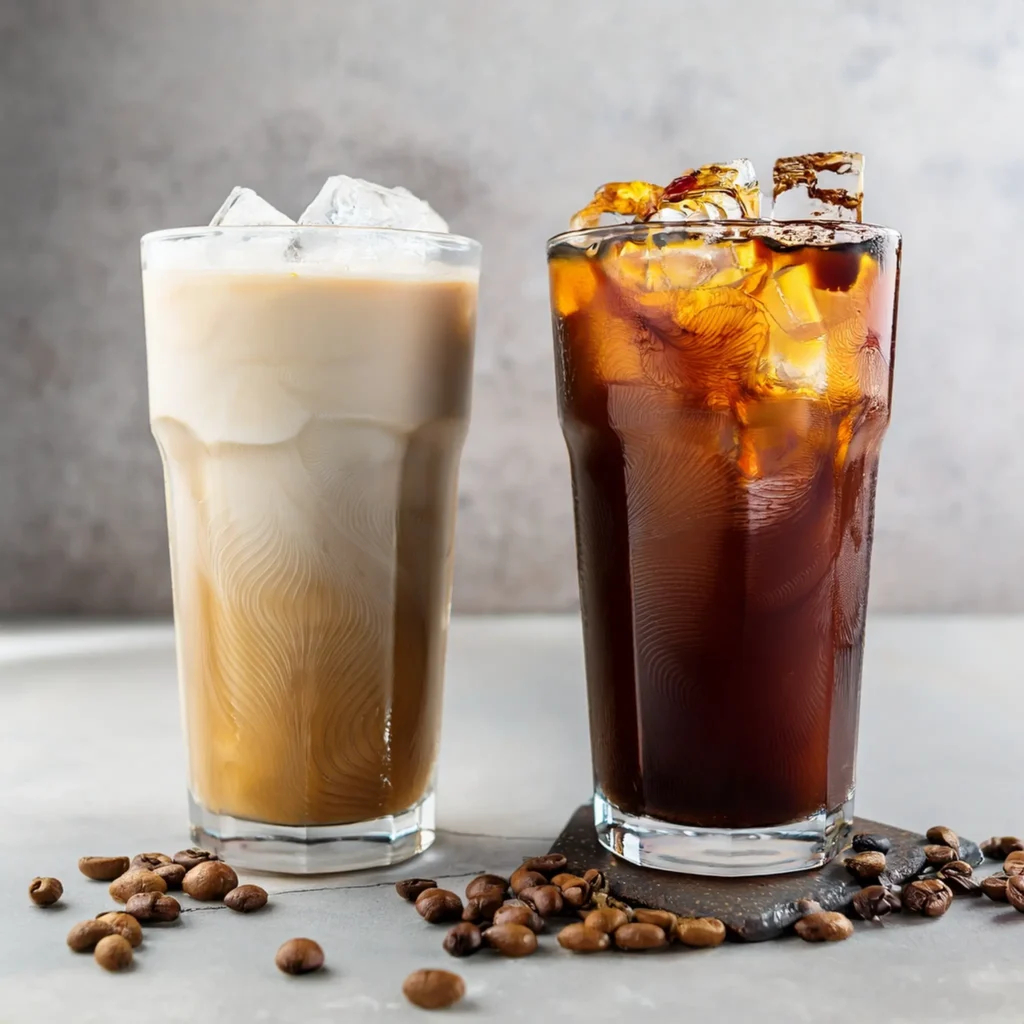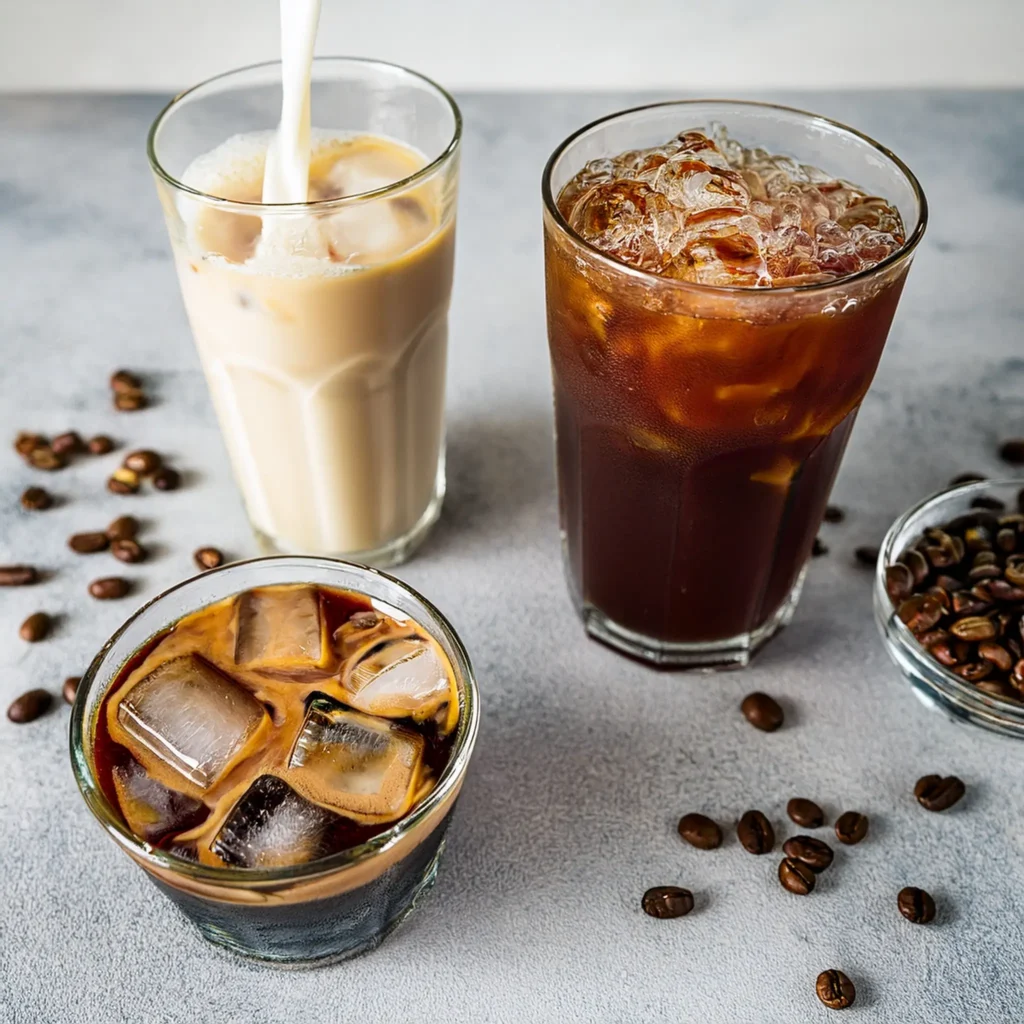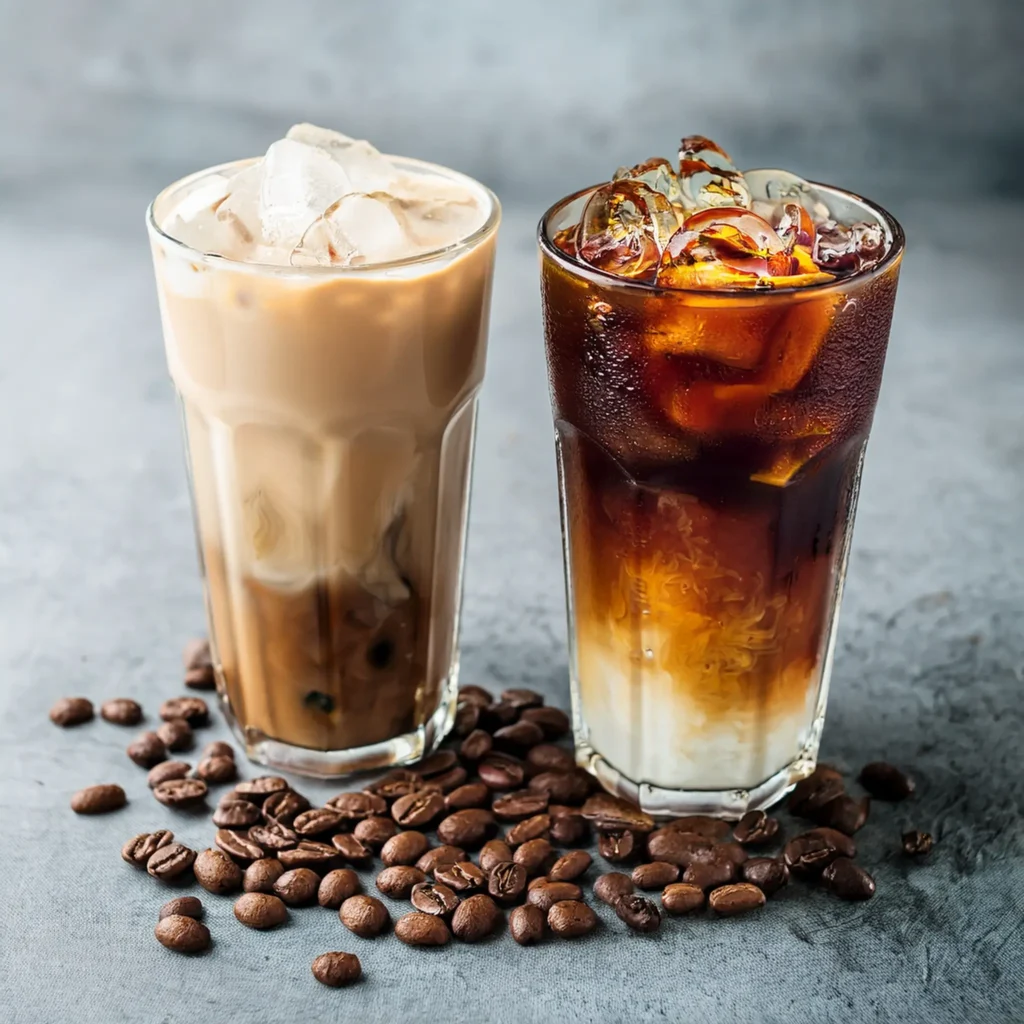Introduction:
Iced Coffee and Latte are two popular beverages that are often confused with each other. Whether you’re a seasoned coffee enthusiast or just starting to explore the world of chilled coffee drinks, understanding the key differences between Iced Coffee vs Latte is essential. In this post, we’ll break down everything you need to know about these two refreshing drinks, from their ingredients to how they’re made, and help you decide which one is your perfect go-to.

1. Iced Coffee vs. Iced Latte: The Basics
1.1 What is Iced Coffee?
Iced coffee is essentially brewed coffee that’s chilled and served over ice. It’s made by brewing coffee (often a stronger, more concentrated brew) and then allowing it to cool. The coffee is served over ice to keep it cold and refreshing. The flavor is bold and rich, often enhanced with sugar, milk, or cream to soften the strong coffee taste.
1.2 What is an Iced Latte?
An iced latte, on the other hand, is made by combining espresso (a concentrated form of coffee) with cold milk and ice. The milk can be any type, from regular cow’s milk to plant-based alternatives like oat or almond milk. The result is a creamy, smooth drink that balances the bitterness of the espresso with the sweetness and richness of the milk.
1.3 Key Differences Between Iced Coffee and Iced Latte
The primary difference between iced coffee and iced latte lies in the base: iced coffee uses brewed coffee, while an iced latte uses espresso. The addition of milk in an iced latte creates a creamier texture and a milder flavor, whereas iced coffee tends to have a more robust, direct coffee flavor.

2. Ingredients in Iced Coffee vs. Iced Latte
2.1 Common Ingredients in Iced Coffee
The basic ingredients in iced coffee are:
- Brewed Coffee: Typically strong brewed coffee (often double-brewed or cold brew).
- Ice: To chill the coffee and create the iced beverage.
- Optional Sweeteners: Sugar, flavored syrups, or honey.
- Milk/Cream: This is optional, but many people prefer to add milk or cream to soften the coffee’s bitterness.
2.2 Common Ingredients in Iced Latte
Iced lattes contain:
- Espresso: The key ingredient that makes iced lattes different from iced coffee.
- Milk: Either steamed or cold milk, depending on your preference, forms the creamy base.
- Ice: Used to chill the drink and provide a refreshing experience.
- Optional Sweeteners: Syrups, sugar, or flavored syrups like vanilla or caramel can be added for sweetness.
2.3 Customizing Your Iced Coffee and Iced Latte
Both drinks are highly customizable:
- For iced coffee, you can adjust the strength by altering the coffee-to-water ratio.
- For iced lattes, the milk-to-espresso ratio can be tweaked to your taste, and you can experiment with different milk alternatives like oat milk or almond milk.

3. How Iced Coffee and Iced Lattes Are Made
3.1 How to Make Iced Coffee
Making iced coffee is a straightforward process:
- Brew the Coffee: Start by brewing your coffee (double brew or cold brew is best for a stronger taste).
- Chill the Coffee: Let the coffee cool to room temperature, or place it in the fridge to cool quickly.
- Serve with Ice: Once chilled, pour the coffee over ice cubes in a glass.
- Customize: Add milk, cream, or sweeteners to taste.
3.2 How to Make an Iced Latte
To make a delicious iced latte:
- Brew Espresso: Brew a shot or two of espresso using your espresso machine.
- Prepare the Milk: Add cold milk to the espresso, adjusting the milk-to-espresso ratio to your preference.
- Add Ice: Fill a glass with ice, then pour the espresso-milk mixture over it.
- Sweeten to Taste: Add sugar, syrups, or flavored syrups if desired.
3.3 Differences in the Brewing Process
Iced coffee typically involves brewing a larger batch of coffee, whereas an iced latte requires brewing a smaller amount of espresso but mixing it with more milk. The result is that iced lattes are generally creamier and less intense in flavor compared to iced coffee.

4. Flavor Profile: Iced Coffee vs. Iced Latte
4.1 The Bold Flavor of Iced Coffee
Iced coffee has a strong, intense coffee flavor due to the brewed coffee base. It’s more bitter and robust, especially when served black. The addition of sweeteners and milk can balance this bitterness, but the overall flavor remains dominated by the coffee.
4.2 The Creamy Taste of Iced Latte
Iced lattes have a smoother, creamier texture due to the milk. The espresso’s strong flavor is softened by the milk, resulting in a balanced, less bitter taste. Depending on the milk used, iced lattes can take on different flavor profiles — for example, oat milk adds a natural sweetness.
4.3 Which One Is Right for You?
- Choose Iced Coffee if you prefer a stronger, bolder coffee flavor with a refreshing kick.
- Choose Iced Latte if you like a smoother, creamier coffee experience that’s milder and more indulgent.

5. Nutritional Comparison: Iced Coffee vs. Iced Latte
5.1 Calories and Sugar Content in Iced Coffee
Iced coffee can be a low-calorie drink, especially if you drink it black. However, adding milk, cream, or sweeteners will increase the calorie and sugar content. A simple iced coffee without milk or syrup has around 5 calories, but adding cream or syrup can bring the total to 150-200 calories per serving.
5.2 Calories and Sugar Content in Iced Latte
Iced lattes tend to have more calories due to the milk, which provides natural sugars and fat. A standard iced latte with regular milk typically contains 120-200 calories, depending on the size and the type of milk used. Opting for a non-dairy milk can alter the calorie count as well, with oat milk generally adding more calories than almond milk.
5.3 Choosing Healthier Options
If you’re looking to cut down on calories or sugar:
- Opt for unsweetened milk alternatives (such as almond or coconut milk) to reduce the calorie count in both drinks.
- Skip or reduce the amount of flavored syrups or sweeteners to keep the drink healthier.
Conclusion:
Iced coffee and iced lattes are two of the most popular cold coffee drinks, each offering its unique characteristics. Iced coffee is bold and refreshing, while iced lattes provide a creamy, milder flavor. Understanding the differences in their ingredients, preparation methods, and flavors can help you decide which one best suits your taste. Whether you prefer the strong coffee taste of iced coffee or the smooth texture of an iced latte, both drinks are perfect for hot days or any time you want a cool coffee treat.
👉 Ready to make your own iced coffee at home? Check out our full collection of iced coffee recipes!



